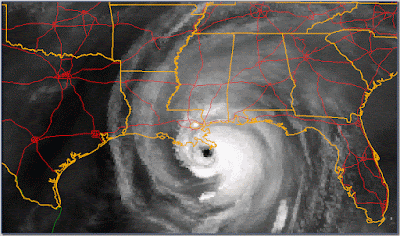 |
| GOES-12 Visible imagery of Katrina |
 |
| GOES-12 Infrared (IR4) imagery of Katrina |
 |
| GOES-12 Water Vapor (IR3) imagery of Katrina |
Finally, at 9:45 am CDT, Katrina made its third and last landfall near the mouth of the Pearl River at the Louisiana/Mississippi border, still as a category 3 hurricane. However, these winds were likely limited to portions of the storm still over water and just east of the eye. Thus, the city of New Orleans did not experience category 3 winds, and likely only experienced category 2 winds briefly. This analysis is complicated by the fact that New Orleans is a fair sized city with high rise buildings downtown. It turns out that the strongest winds in a tropical cyclone are found several hundred meters above the surface, thus the tops of very high buildings will experience a noticeably higher wind speed than their bases. As a rough example, the 25th floor of a high rise will likely be impacted by winds one category higher than at the surface.
After landfall, Katrina began accelerating northward and began turning east while weakening rapidly. Despite this, its' tropical storm force wind radius remained large, even as its' hurricane force radius shrunk significantly. By 1:00 pm, New Orleans was still experiencing storm force winds, thus the city was subjected to at least tropical storm force winds for over 18 hours. The storm also produced heavy precipitation along and just west of its path, including a measured 11.63" at the Slidell NWS office. As it continued inland, it weakened to a tropical storm at 7:00 pm CDT, yet still produced precipitation totals of 4" to 8" over inland Mississippi.
What did the most damage in the New Orleans area was floodwater. This occurred as a result of Lake Pontchartrain overflowing its banks and levees breaking. In this respect, the extraordinary damage New Orleans suffered was due to both a natural and a man-made disaster. The official Tropical Cyclone Report for Hurricane Katrina summarized the flooding damage:
"Although the storm surge was highest to the east of the path of the eye of Katrina, a very significant storm surge also occurred west of the path of the eye. As the level of Lake Pontchartrain rose, several feet of water were pushed into communities along its northeastern shore in St. Tammany Parish from Slidell to Mandeville, Louisiana. High water mark data indicate the storm surge was 12 to 16 ft in those areas. The data also indicate a storm surge of 15 to 19 ft occurred in eastern New Orleans, St. Bernard Parish, and Plaquemines Parish, while the surge was 10 to 14 ft in western New Orleans along the southern shores of Lake Pontchartrain. Farther west, observations indicate a storm surge of 5 to 10 ft along the shores of western Lake Pontchartrain. The surge severely strained the levee system in the New Orleans area. Several of the levees and floodwalls were overtopped and/or breached at different times on the day of landfall. Most of the floodwall and levee breaches were due to erosion on the back side caused by overtopping, but a few breaches occurred before the waters reached the tops of the floodwalls. The surge overtopped large sections of the levees east of New Orleans, in Orleans Parish and St. Bernard Parish, and it also pushed water up the Intracoastal Waterway and into the Industrial Canal. The water rise in Lake Pontchartrain strained the floodwalls along the canals adjacent to its southern shore, including the 17th Street Canal and the London Avenue Canal. Breaches along the Industrial Canal east of downtown New Orleans, the London Avenue Canal north of downtown, and the 17th Street Canal northwest of downtown appear to have occurred during the early morning on 29 August. Overall, about 80% of the city of New Orleans flooded, to varying depths up to about 20 ft, within a day or so after landfall of the eye."
 |
| New Orleans before (top) and after (bottom) Katrina. Notice how most streets flooded and a major levee breach can be seen in the far right side of the image. |
Elsewhere, storm surge was by far the greatest threat. Along a 20 mi swath of coastline, centered on St. Louis Bay, storm surge was 24 to 28 feet. Storm surge values remained in the 17 to 22 ft range as far east as Pascagoula, MS. In many places, the surge extended as much as 6 mi inland and up to 12 mi along bays and rivers. Even further east, Dauphin Island, off the coast of Alabama, was effectively cut in two when the storm surge carved a new inlet a mile wide. Furthermore, 64 mi south of Dauphin Island, a NOAA bouy reported a peak significant wave height (defined as the average of the one-third highest waves) of 55 ft at around 6:00 am CDT.
 |
| Dauphin Island before (top) and after (bottom) Katrina. The inlet that developed was over a mile wide. |









No comments:
Post a Comment